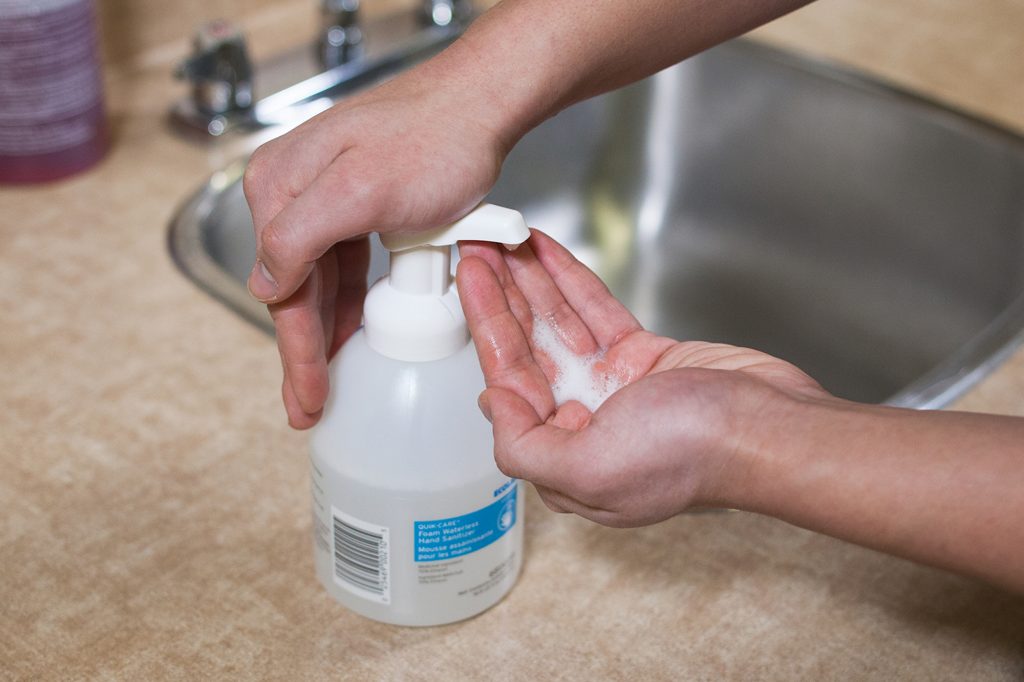4.7 Infection Prevention and Control
Infection prevention and control (IPAC) refers to practices that prevent or reduce the transmission of microorganisms.
As a health care professional, you have an important role to play in IPAC, and so do clients, care partners, and visitors. You should educate clients, care partners, and visitors about appropriate IPAC measures. Health care institutions usually display signs indicating to clients and visitors when to wash their hands or wear a mask, but nurses also play an important role in reminding people about their shared responsibility in reducing the spread of disease, particularly when specific precaution protocols are in place (e.g., in an isolation room, wearing a mask if someone has a cough).
Clinical Tip
The #1 action you can take to prevent health care-associated infections (HAI) is hand hygiene (World Health Organization, 2024).
Hand hygiene practices include: using an alcohol-based hand rub (ABHR), sometimes referred to as hand hygiene gel/hand sanitizer, and handwashing with soap and water (see Figure 4.3). It may also include surgical hand antisepsis, which is beyond the scope of this chapter.

Certain occasions will require handwashing instead of relying on ABHR. You must wash your hands with soap and water if your hands are visibly soiled, have been exposed to any body fluids, have been exposed to norovirus or clostridium difficile, and following glove removal (CDC, 2024). The mechanical action of washing hands is important to remove bacteria.
Watch the film clip below for how to properly wash your hands.
Reusable equipment that touches intact skin and does not touch mucous membranes must be cleaned between clients. Examples of this equipment include stethoscopes, BP cuffs, and pulse oximeters. Most of this equipment does not become visibly soiled, so disinfecting the equipment with a wipe is usually sufficient (IPAC, 2018).
You should also consider your own health and safety as you provide care to clients. Personal protective equipment (PPE) such as gloves, masks, gowns, goggles, and face shields can prevent you from contact with microorganisms. Other precautions to think about include being mindful not to touch your face as you provide care, because bacteria such as MRSA (methicillin-resistant staphylococcus aureus) and COVID-19 can live in the nasal passage for extended periods of time. Other ways to reduce exposure to microorganisms is to keep nails trimmed short and to keep hair tied back if it is longer than your shoulders. Avoid wearing jewelry and nail polish as they can harbor microorganisms. In addition to using PPE when appropriate, you may need to use isolation precautions for a client with a known or suspected infectious disease.
References
Centers for Disease Control and Prevention. (2024, March 12). Hand sanitizer guidelines and recommendations. https://www.cdc.gov/clean-hands/about/hand-sanitizer.html
World Health Organization. (2021). Key facts and figures World Hand Hygiene Day 2021. https://www.who.int/campaigns/world-hand-hygiene-day/2021/key-facts-and-figures
Attribution
This section contains material taken from The Complete Subjective Health Assessment by Jennifer Lapum, Oona St-Amant, Michelle Hughes, Paul Petrie, Sherry Morrell, and Sita Mistry and is licensed under a Creative Commons Attribution-ShareAlike 4.0 International License.

